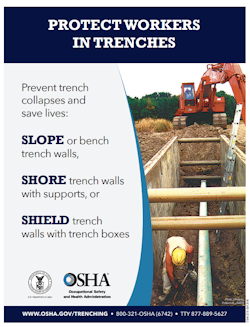Methods of Protection
All excavations are hazardous because they are inherently unstable. If they are restricted spaces, they present the additional risks of oxygen depletion, toxic fumes, and water accumulation. If you are not using protective systems or equipment while working in trenches or excavations at your site, you are in danger of suffocating, inhaling toxic materials, fire, drowning, or being crushed by a cave-in.
OSHA standard 1926.652, Requirements for protective systems, details four types of protective systems.
- Sloping and Benching. This method is considered the safest of the four methods. It involves cutting back the trench wall at an angle inclined away from the excavation.
- Timber shoring. This method requires installing aluminum hydraulic, pneumatic, or other types of supports to shore up the trench face to prevent soil movement.
- Shielding. This method is the most common system used and protects workers with trench boxes or other types of supports to prevent soil cave-ins.
- Engineered design. A licensed engineer designs protection systems for large complex construction projects.
Designing a protective system can be complex because you must consider many factors: soil classification, depth of cut, water content of soil, changes due to weather or climate, surcharge loads such as spoil and other materials used in the trench, and other nearby operations such as heavy equipment and vehicle traffic.
Requirements
(1)Each employee in an excavation shall be protected from cave-ins by an adequate protective system designed in accordance with paragraph (b) or (c) of this section except when:
- (i)Excavations are made entirely in stable rock; or
- (ii)Excavations are less than 5 feet (1.52m) in depth and examination of the ground by a competent person provides no indication of a potential cave-in.
(2) Protective systems shall have the capacity to resist without failure all loads that are intended or could reasonably be expected to be applied or transmitted to the system.
See Requirements for Protection Systems" for detailed slope configurations.
(a) Scope and application. This appendix contains specifications for sloping and benching when used as methods of protecting employees working in excavations from cave-ins. The requirements of this appendix apply when the design of sloping and benching protective systems is to be performed in accordance with the requirements set forth in 1926.652(b)(2).
(b) Definitions.
Actual slope means the slope to which an excavation face is excavated.
Distress means that the soil is in a condition where a cave-in is imminent or is likely to occur. Distress is evidenced by such phenomena as the development of fissures in the face of or adjacent to an open excavation; the subsidence of the edge of an excavation; the slumping of material from the face or the bulging or heaving of material from the bottom of an excavation; the spalling of material from the face of an excavation; and ravelling, i.e., small amounts of material such as pebbles or little clumps of material suddenly separating from the face of an excavation and trickling or rolling down into the excavation.
Maximum allowable slope means the steepest incline of an excavation face that is acceptable for the most favorable site conditions as protection against cave-ins, and is expressed as the ratio of horizontal distance to vertical rise (H:V).
Short term exposure means a period of time less than or equal to 24 hours that an excavation is open.
Knowledge Check Choose the best answer for the question.
4-1. Which is considered the safest method to prevent an excavation wall collapse?
You forgot to answer the question!

